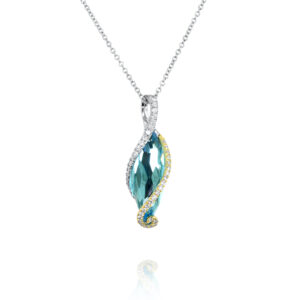By Yehouda Saketkhou, Yael Designs
Color inspires confidence. You can put on your favorite color—and favorite colored gemstone jewelry—and feel unstoppable. This is a fact which I started to take more seriously about six years ago. I was at a fundraising party for a Burning Man event and the cacophony of wild colors and attire was intoxicatingly joyful. That rainbow of colors made me realize that I should encourage my Yael Designs’ clients to think more about the hues that make them happy (and why).

After all, color can be the main reason for purchasing a product, so having an array of colors in your display case is a great way to draw attention and excitement from your customers. Colored gemstones not only are beautiful and valuable, but they are also believed to have a psychological effect on the wearer. The color of a gemstone is said to have a profound impact on a person’s mood, emotions, and overall well-being. This is why at Yael Designs, we now ask, “What’s your color?”
Specifically, I instructed my sales team to start asking that question at trunk shows. The answer can help guide a customer to the jewelry that is most compelling to them. It’s also the start of a conversation that can feel very personal and intentional, and disarming to the sale process. It becomes much more than about the gemstone. It encourages a connection fueled by emotion rather than just what is seen. It is felt.
Color Properties
Clients’ colors may be associated with their favorite season or place. The blue skies or tropical ocean waters. Maybe the deep green of a tourmaline matches the color of someone’s eyes, or the blue of a sapphire reminds someone of the ocean that they visited on their favorite vacations with their favorite people. Asking the question “What’s your color” as a conversation starter allows the consumer to tap into themselves and answer with their heart.
Blue is consistently a fave color worldwide, followed by green and red. Blue can be admired in many natural environments, from the ocean to the sky, and in beautiful naturally occurring gemstones like Sapphire, Indicolite, Paraíba Tourmaline, Aquamarine, Spinel, and Turquoise. Blue is said to be a calming color and provides a sense of tranquility and peace. Blue is also the color of the fifth chakra, the throat chakra, and represents trust, loyalty, and honesty, so it’s no surprise that this is such a favorite among so many people.

Meanwhile, green gemstones such as Emerald and Peridot are associated with growth, renewal, and balance. Wearing green jewelry can also help one connect with nature and feel a sense of stability and harmony.
Yellow gemstones like Citrine and Topaz are associated with joy, optimism, and creativity. Wearing yellow jewelry can brighten one’s mood and boost creativity. Purple gemstones like Amethyst and purple Sapphire are associated with intuition, spirituality, and wisdom. Wearing purple jewelry can enhance intuition and promote spiritual growth. (There’s also a nugget of obscure gemstone lore that insists Amethyst cures drunkenness, but that’s a topic for another article.)
Then there are red gemstones such as Ruby, red Spinel, rubellite Tourmaline, and Garnet that are associated with energy, passion, and confidence. Red is a powerful color, so wearing red jewelry can boost self-esteem and give one a feeling of strength. It is the color associated with passion, energy, courage, desire, and love, but it can also be a grounding color that inspires confidence. Many women have their favorite shade of red lipstick, and as soon as they apply it, it provides an immediate boost of confidence. Interestingly, the first chakra, the root chakra, is associated with the color red. This chakra is located at the base of the spine. Red is also associated with heroism and is featured in about 77% of all national flags. In China, red symbolizes happiness, success, and good fortune, and brides in China often wear red dresses because it is the color that many associate with success, love, and loyalty.

Finally, pink gemstones such as rose Quartz and Tourmaline are associated with love, compassion, and tranquility. Wearing pink jewelry can promote feelings of love and kindness, both towards oneself and others.
Connecting With Clients
Colors have many associations with different chakras in the body and hold energy that can be a powerful tool in the overall alignment and well-being of a person. And while not everybody follows these beliefs, everyone can appreciate pretty colors. Whether tied to energy or emotion, color is a tool that retailers can use to expand their market and reach people on a more personal level.

Thus far, Yael Designs has trademarked What’s Your Color and uses it as a signature hashtag on social media, but we would love to see more individuals in jewelry repeat it and create awareness for it. Jewelry is an emotional purchase, and we’ve found that asking clients about their favorite colors subtly taps into consumer psychology, engaging with clients in a way that brings down their guard in store. Asking the question starts a whole different conversation—a decidedly personal one that doesn’t feel like a hard sell.
What’s your color works well for us; we encourage more AGTA members to use the question at the counter to get conversations going. In our experience, the question ultimately leads to sales in about 60% of occasions used. It also helps create lifelong relationships.
This is proprietary content for AGTA and may not be reproduced.
